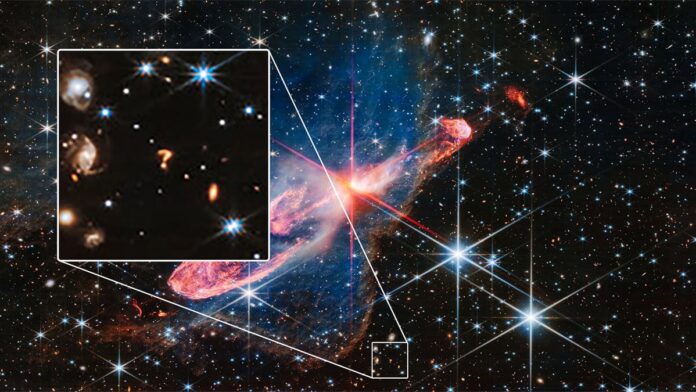(CNN) — A cosmic object in the shape of a glowing question mark has photobombed one of the latest images captured by NASA’s James Webb Space Telescope — and scientists think they know what it might be.
The original near-infrared image, released July 26, depicted a pair of young stars named Herbig-Haro 46/47. Found 1,470 light-years away in the Vela constellation within the Milky Way galaxy, the stars are still actively forming and closely orbiting each other.
The two have been observed and studied by space and ground-based telescopes since the 1950s, but the highly sensitive Webb telescope allowed for the highest-resolution and most detailed image yet. It has the capacity to observe the universe with longer wavelengths of light than other space telescopes.
The Webb telescope illuminates information about the origins of our universe, but the appearance of this mysterious object in the background of this image leaves more questions than answers. The cosmic question mark hasn’t been closely observed or studied, so scientists aren’t exactly sure about the object’s origins and makeup.
But they do have a few ideas based on its shape and location.
“The very first thing you can rule out is that it’s a star in the Milky Way,” said Matt Caplan, assistant professor of physics at Illinois State University. “Stars always have these really big spikes, and that’s because stars are point-like. It’s called diffraction from basically the edges of the mirrors and the struts that support the sort of camera in the middle.”
The Webb telescope usually allows you to see six or eight stellar “prongs” if you look closely, Caplan added. “It tells you immediately that it’s not a star,” he said of the question-mark-shaped phenomenon.
It could be a merger of two galaxies that, at probably billions of light-years away, are much farther away than Herbig-Haro 46/47, said Christopher Britt, education and outreach scientist in the office of public outreach at the Space Telescope Science Institute, which manages the Webb telescope’s science operations.
There are “many, many galaxies outside of our own Milky Way,” Britt said. “This looks like the kind of thing that you get fairly frequently — as galaxies grow and evolve over cosmic time — which is that they sometimes collide with their near neighbors.
“And when that happens, they can get distorted into all kinds of different shapes — including a question mark, apparently.”
The-CNN-Wire
™ & © 2023 Cable News Network, Inc., a Warner Bros. Discovery Company. All rights reserved.



